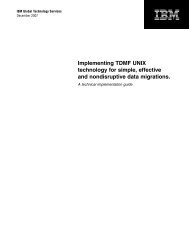A Primer for Healthcare Managers - IBM
A Primer for Healthcare Managers - IBM
A Primer for Healthcare Managers - IBM
You also want an ePaper? Increase the reach of your titles
YUMPU automatically turns print PDFs into web optimized ePapers that Google loves.
interrelated issues at various stages, management<br />
support needs to be there at every stage of the<br />
process. A recent General Accounting Office (GAO)<br />
report on desktop outsourcing has confirmed the<br />
importance of high-level management support<br />
(GAO, March 2002). Top management involvement<br />
is particularly helpful in the transition from existing<br />
in-house service provision to a vendor. At minimum,<br />
there should be a management team that oversees<br />
the entire process of the outsourcing arrangement.<br />
Moreover, management should allocate enough<br />
time and sustain resource input <strong>for</strong> all stages of the<br />
outsourcing process. One of the common problems<br />
<strong>for</strong> IT outsourcing is underestimating the time and<br />
resources involved. A successful outsourcing project<br />
requires an intensive analysis of organizational<br />
needs, which is time consuming and resource intensive.<br />
The subsequent contract negotiation, transition,<br />
and implementation are equally demanding <strong>for</strong> time<br />
and resource input if the goal is to have a structured<br />
contract with smooth implementation.<br />
The IT outsourcing management team needs to<br />
have strong procurement and relationship management<br />
skills and knowledge. IT outsourcing demands<br />
that the management team has the appropriate<br />
knowledge and skills about vendor selection,<br />
contract negotiation, and contract implementation.<br />
The relationship-based nature of successful outsourcing<br />
requires a partnership perspective. The outsourcing<br />
of desktop services has demonstrated this point<br />
(GAO, March 2002). A management team needs to<br />
update its knowledge and skills continuously.<br />
Critical Success Factors<br />
<strong>for</strong> IT Outsourcing<br />
• Top management support and involvement<br />
• Ample time and resource input<br />
• Strong procurement and relationship<br />
management skills<br />
• Continuous learning and service benchmarking<br />
• Frequent communication between organizations<br />
and their service providers<br />
The fast-changing nature of technology <strong>for</strong>ces the<br />
management team to constantly learn about the<br />
best service model and adapt to it. <strong>Managers</strong> at<br />
various organizations have been developing new<br />
management tools, such as flexible payments based<br />
on service use. Given that, utilizing a learning network<br />
through professional organizations is a good way<br />
of keeping the management team updated. For<br />
example, human resource staffs can learn from one<br />
another about best practices in IT outsourcing <strong>for</strong><br />
HR services. This is particularly the case in the in<strong>for</strong>mation<br />
assurance area, which has a short history of<br />
development. With a new understanding of security<br />
vulnerabilities, managers need to devise a better<br />
service management strategy.<br />
Frequent communication of technical and management<br />
issues should occur at all phases. This is<br />
critical <strong>for</strong> maintaining a partnership that hinges<br />
on a common understanding of the long-term<br />
mutual benefits. The constant exchange of vital<br />
in<strong>for</strong>mation helps manage the IT outsourcing<br />
relationship. Moreover, frequent communication is<br />
the main mechanism to address changes in priority<br />
and service needs. In<strong>for</strong>mation assurance was not a<br />
priority of in<strong>for</strong>mation technology service a few years<br />
ago, but it is a top priority today. Service needs may<br />
change significantly in about a year and may<br />
warrant a refinement of the per<strong>for</strong>mance matrix<br />
(Dorobek, 2002). Since change is the only constant,<br />
frequent communication is required <strong>for</strong> agencies and<br />
vendors to work together to focus on results that are<br />
responsive to new needs. Although the focus may be<br />
different at different stages, the main principle stays<br />
the same—frequent and open communication.<br />
A Process Model<br />
A process-oriented model is an effective tool <strong>for</strong><br />
managers to manage IT outsourcing from start to<br />
finish. A graphic illustration of the model is captured in<br />
Figure 2. The process begins with a clear definition<br />
of organizational goals and how a sourcing strategy<br />
would help achieve these goals. Within that framework,<br />
in Phase 2, sourcing needs are analyzed and<br />
the operational relationships are designed to meet<br />
those needs. Phase 3 follows and focuses on vendor<br />
selection and contract negotiation. In the process<br />
model, there is a strong emphasis on analysis and<br />
design of service needs and the contract because<br />
they lay the foundation <strong>for</strong> actual implementation.<br />
The fourth phase is the transition to the external<br />
service provider, and the last phase is the management<br />
of service per<strong>for</strong>mance. There could be an<br />
overlap between the last two phases when the<br />
transition is done incrementally.<br />
<strong>IBM</strong> Center <strong>for</strong> <strong>Healthcare</strong> Management 11

















